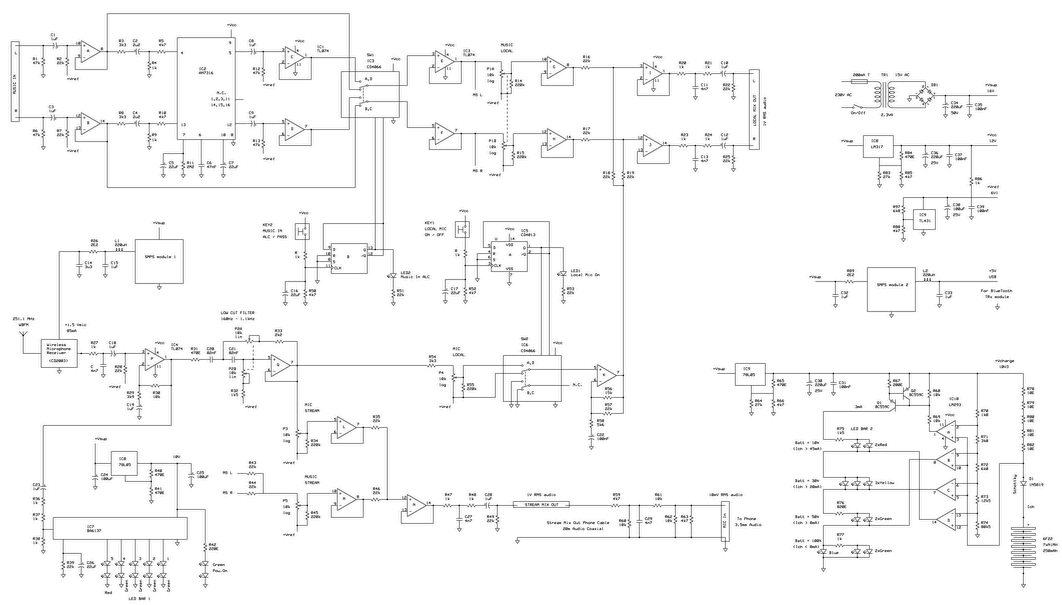
In order to keep the things as simple as possible, while at the same time providing integrity of high quality audio, the complete audio path is directly coupled and referenced to +Vcc/2. All Op Amp stages are simple unitary gain buffers so they introduce no distortion. Amplitude of all audio signals is kept to 1 Vrms or less so +12 Vcc provides for clipping-free operation. We choose TL074 as high quality but very inexpensive chips that let us sprinkle them around in large quantities where ever we found desirable :)
Automatic Level Control
The most notable unusual feature of this console is automatic leveling of input music signal. Whatever the source: CD, portable music player, streaming service etc. levels are often not very consistent which leads to the necessity of frequent adjustment of volume control - not at all desirable when leading a class. Thus Sky Mixer has a dedicated IC AN7316 built in it. It had originally been designed for Automatic Level Control in HiFi tape recorders a few decades ago and contains a pair of variable gain amplifiers that automatically adjust their gain so that output audio signal level is kept more or less constant. That function was very useful for keeping the level of tape magentisation within the relatively narrow optimal range, and works quite well in practice so that input audio level is alowed to vary approximately 40dB (i.e. 100 times in amplitude!) without noticable changes at IC outputs. AN7316 is a HiFi version of the more common AN7312 chip often used in cheap boom boxes. Distortion is typically around 0.1% and bandwidth wide enough to label AN7316 "HiFi". Attack and decay constants of this compressor stage cannot be adjusted independently but the circuit performs very satisfactorily in practice. One can easily by-pass it via IC3 by toggling the flip-flop B in IC5 if A.L.C. effects are annoying, but in Sky Gym A.L.C. is so admired that it is simply kept always on.
Microphone signal conditioning
The only two exceptions from unity gain rule are Op amps P and Q that condition the raw Mic signal. P amplifier operates with gain of 3.5X in order to bring the Mic signal to the same level as Music signal. Q is an adjustable 12dB/oct Low-Cut filter that filters out bass frequencies that come from the microphone. This prevents annoying microphony, ecchoing and wobbling in bass range produced by uncontrolled reflections from uncovered flat concrete walls in a relatively large exercise room. Subfoower pumping and tiny delays due to digital audio processing in modern power amplifiers can make such artifacts very obvious without this filter. One can set the bottom frequency of Mic audio band from 160 Hz to 1.1 kHz using a single stereo linear pot.
Microphone signal level cannot be automatically normalised using an A.L.C. circuit similar to the one described above because such proseccing would guarantee strong microphony 99% of the time. So we put a visual indication of Mic input signal level on the front side of the console housing in the form of an LED-bar. It is controled by a dedicated BA6137 SIL IC. Large green/yellow/red LEDs provide easy to interpret indication so that one can adjust mic gain on the belt hanging Mic transmitter unit. Led-bar has a dedicated voltage stabiliser in order to keep the switching artifacts away from the audio path.
Streaming mix outputs
In order to enable propper adjustment of music and mic signals for streaming purposes, we built in the second chain of pots and op amps. It is mono because most current smart devices, as well as streaming platforms do not support stereo because they do not find it particualarly useful. We provided a line level streaming audio output that can be fed into a BlueTooth transmitter, which would then forward the audio to a cell phone, tablet or a computer.
Streaming audio mix can also be fed directly into a headphone/mic socket of a phone via a thin coax cable that contains an attenuator. Although it might seem tiny, 10 mV rms it produces seems to be very Ok with most smart phone models we tested because such is the level of audio typically produced by external phone microphones. This second means of feeding the streaming mix to the net is preferred in practice because BT connection seems to introduce quite a noticeable delay, so that audio lags the video in an A/V stream. BT 5.0 standard promisses to solve this issue, but we weren't lucky with one such chipo we tested.
It turned out that the same tiny BT TRx device is more useful for providing the auxiliary audio input for music signal e.g. for playing music via a smart phone. Thus we put yet another input connector to the back side of the console. Line music input and BT music input can be used simoultaneously because their signals get mixed passively via input resistors. This feature is not used in practice, but both inputs can be connected to source devices without ill consequences to audio or electronics.

